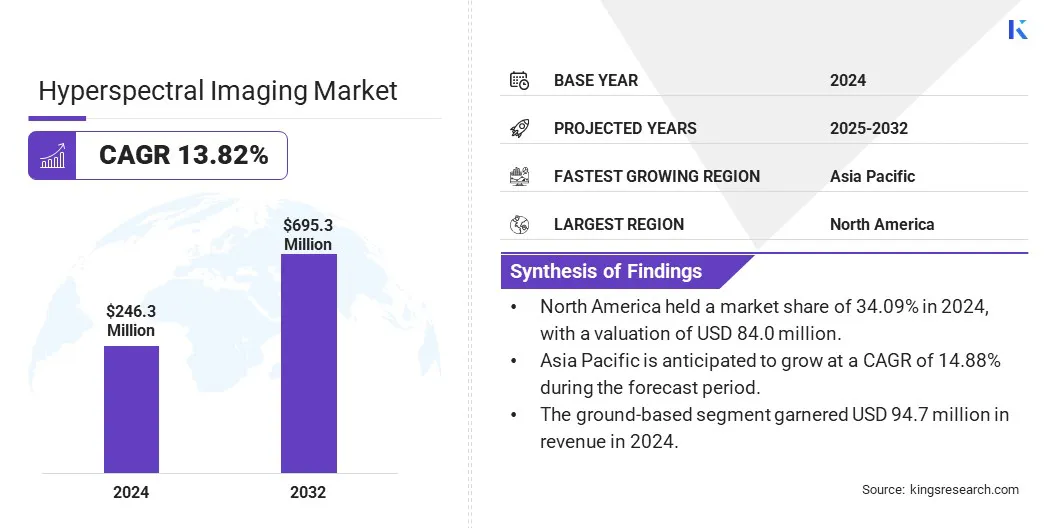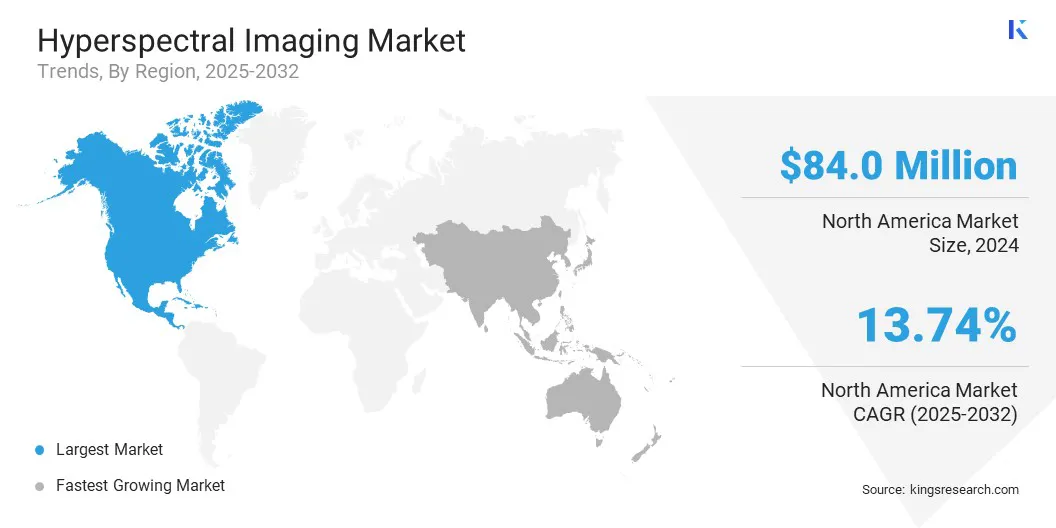Market Definition
The market encompasses a broad ecosystem of technologies, platforms, applications, and end users focused on capturing and analyzing spectral information across a wide range of wavelengths.
Solutions in this market are deployed through ground-based systems, aerial platforms such as drones and aircraft, and satellite-based infrastructure, enabling diverse operational capabilities. These technologies support a range of applications including remote sensing, machine vision, research and diagnostics, environmental monitoring and surveillance.
The report presents an overview of the primary growth drivers, supported by regional analysis and regulatory frameworks expected to impact market development over the forecast period.
Hyperspectral Imaging Market Overview
The global hyperspectral imaging market size was valued at USD 246.3 million in 2024 and is projected to grow from USD 279.9 million in 2025 to USD 695.3 million by 2032, exhibiting a CAGR of 13.82% during the forecast period.
This growth is driven due to the expanding use of hyperspectral imaging across multiple industries and platforms. Satellite-based systems are a major driver, enabling large-scale remote sensing for applications such as environmental monitoring, land use analysis, and disaster response.
Major companies operating in the hyperspectral imaging industry are Photon Etc., Teledyne Vision Solutions, Photonfocus AG, Resonon Inc., Surface Optics Corporation, Labtron Equipment Ltd., Headwall, HySpex, BaySpec, Inc., HORIBA, Specim, HAIP Solutions GmbH, imec, Paras Defence & Space Technologies, and Cubert GmbH.
The growing use of artificial intelligence to process hyperspectral images is further accelerating market expansion by enabling faster, more accurate data analysis across sectors such as healthcare, defense, and environmental monitoring. Moreover, the rising focus on precision agriculture boosts demand as hyperspectral technology helps monitor crop health and soil conditions in real-time.
- In February 2024, BharatRohan and AgHub partnered to develop hyperspectral spectral libraries to improve pest and disease detection in paddy and cotton crops. The partnership leverages BharatRohan’s expertise in hyperspectral imaging and drone technology to enhance early detection and intervention for crop management, promoting sustainable farming practices and higher yields.

Key Highlights:
- The hyperspectral imaging market size was recorded at USD 246.3 million in 2024.
- The market is projected to grow at a CAGR of 13.82% from 2025 to 2032.
- North America held a market share of 34.09% in 2024, with a valuation of USD 84.0 million.
- The ground-based segment garnered USD 94.7 million in revenue in 2024.
- The remote sensing segment is expected to reach USD 69.2 million by 2032.
- The food & agriculture segment is expected to reach USD 173.4 million by 2032.
- Asia Pacific is anticipated to grow at a CAGR of 14.88% during the forecast period.
Market Driver
Growing integration of hyperspectral imaging in industrial machinery
The market is driven by the increasing integration of hyperspectral systems into industrial machinery. These systems are being widely adopted for quality control, material identification, and defect detection in sectors such as manufacturing, food processing, and pharmaceuticals.
Hyperspectral imaging enables precise, non-destructive analysis of materials on production lines, allowing manufacturers to detect contaminants, ensure uniformity, and improve overall product quality. The growing demand for automation and real-time inspection in industrial environments is driving the adoption of hyperspectral imaging, thereby fueling market growth.
- In May 2023, Specim launched the next-generation near-infrared (NIR) hyperspectral camera, Specim GX17, designed for advanced industrial machine vision. The camera offers a maximum frame rate of 800 Hz with 480 spatial pixels, improving performance by 50% compared to conventional QVGA sensor-based hyperspectral cameras.
Market Challenge
High Cost of Equipment and System Integration
A major challenge in the hyperspectral imaging market is the high cost of equipment and system integration. Hyperspectral cameras, sensors, and processing units are expensive due to their advanced optical and data-handling capabilities. This limits adoption, especially among small and medium-sized enterprises and in cost-sensitive sectors.
Key players are focusing on the development of compact, application-specific systems that reduce overall costs. Additionally, advancements in cloud-based processing and user-friendly software interfaces are helping lower the barrier to entry, making the technology more accessible across various industries.
Market Trend
Rising Use of AI for Processing Hyperspectral Images
The market is witnessing a shift towards the integration of artificial intelligence for image processing. AI-powered algorithms are increasingly being used to analyze hyperspectral data, enabling faster interpretation and enhanced accuracy in pattern recognition, classification, and anomaly detection.
This transformation is particularly evident in agriculture, healthcare, and defense, where real-time, high-precision insights are essential. By automating data analysis, AI reduces processing time and human error, making hyperspectral imaging more efficient and scalable for real-time applications.
- In April 2024, KP Labs announced the successful capture and AI-based onboard processing of the first hyperspectral images by the Intuition-1 satellite. Launched in November 2023 aboard the SpaceX Falcon 9 rocket, the satellite provides detailed observations of the equatorial region using a sensor covering 192 spectral bands.
Hyperspectral Imaging Market Report Snapshot
|
Segmentation
|
Details
|
|
By Platform
|
Ground-based, Aerial, Satellite-based
|
|
By Application
|
Remote Sensing, Machine Vision, Research & Diagnostics, Monitoring & Surveillance, Others
|
|
By End User
|
Food & Agriculture, Healthcare, Aerospace & Defense, Mining & Metrology, Environmental Monitoring, Others
|
|
By Region
|
North America: U.S., Canada, Mexico
|
|
Europe: France, UK, Spain, Germany, Italy, Russia, Rest of Europe
|
|
Asia-Pacific: China, Japan, India, Australia, ASEAN, South Korea, Rest of Asia-Pacific
|
|
Middle East & Africa: Turkey, U.A.E., Saudi Arabia, South Africa, Rest of Middle East & Africa
|
|
South America: Brazil, Argentina, Rest of South America
|
Market Segmentation:
- By Platform (Ground-based, Aerial, Satellite-based): The ground-based segment earned USD 94.7 million in 2024 due to its widespread use in lab testing, quality control, and close-range environmental monitoring.
- By Application (Remote Sensing, Machine Vision, Research & Diagnostics, and Monitoring & Surveillance): The remote sensing segment held 28.08% of the market in 2024, due to its adoption in precision agriculture, land use analysis, and climate research.
- By End User (Food & Agriculture, Healthcare, Aerospace & Defense, and Mining & Metrology): The food & agriculture segment is projected to reach USD 173.4 million by 2032, owing to increasing demand for crop monitoring, soil analysis, and quality assessment in food production.
Hyperspectral Imaging Market Regional Analysis
Based on region, the global market has been classified into North America, Europe, Asia Pacific, Middle East & Africa, and South America.

North America hyperspectral imaging market share stood at around 34.09% in 2024 in the global market, with a valuation of USD 84.0 million. This dominance is driven by strong investments in aerospace and defense, advanced healthcare infrastructure, and early adoption of remote sensing technologies.
The presence of major research institutions and government-funded space and environmental monitoring programs is further supporting market expansion in this region.
Asia Pacific is poised to grow at a significant CAGR of 14.88% over the forecast period. The growth is driven by rising demand for hyperspectral imaging solutions across agriculture, environmental monitoring, and industrial inspection.
Increasing investments in satellite programs, growing food security concerns, and expanding manufacturing capabilities are further accelerating the adoption of hyperspectral imaging solutions in countries like China, India, and Japan.
- In June 2024, the Indian Ministry of Defence signed its 350th contract with SpacePixxel Technologies Pvt Ltd under its Innovations for Defence Excellence (iDEX) framework. The partnership focuses on designing and developing a miniaturized satellite capable of carrying multiple payloads, including Electro-Optical, Infrared, Synthetic Aperture Radar, and Hyperspectral sensors, up to 150 kg for the Indian Air Force.
Regulatory Frameworks
- In the U.S., hyperspectral imaging technologies used in healthcare and food safety are regulated by the U.S. Food and Drug Administration (FDA) and the U.S. Department of Agriculture (USDA), particularly under guidelines related to medical imaging devices and food inspection systems.
- In Europe, hyperspectral imaging equipment falls under the EU Medical Device Regulation (MDR 2017/745) when used for diagnostic applications, and the General Product Safety Directive for non-medical uses, ensuring product compliance and safety standards.
Competitive Landscape
The key players in the hyperspectral imaging market are focusing on technology advancement, product differentiation, and strategic collaborations. Companies are actively investing in research and development to enhance spatial and spectral resolution, reduce system size, and improve processing speed.
Additionally, market players are expanding their portfolios through the development of compact, portable systems tailored for specific industries such as agriculture, healthcare, and defense. Several market participants are entering into multi-year contracts for remote sensing and surveillance applications, particularly in defense and environmental monitoring.
Moreover, key players actively investing in R&D to integrate artificial intelligence and machine learning into hyperspectral data processing for real-time analysis and automation.
- In August 2024, Planet Labs PBC launched its first hyperspectral satellite, Tanager-1, along with 36 SuperDoves during the Transporter-11 rideshare mission with SpaceX. The partnership focused on deploying advanced imaging spectrometer technology developed with NASA’s Jet Propulsion Laboratory to detect and track methane and CO2 super-emitters, supporting environmental monitoring and mitigation efforts through the Carbon Mapper Coalition.
List of Key Companies in Hyperspectral Imaging Market:
- Photon Etc.
- Teledyne Vision Solutions
- Photonfocus AG
- Resonon Inc.
- Surface Optics Corporation
- Labtron Equipment Ltd.
- Headwall
- HySpex
- BaySpec, Inc.
- HORIBA
- Specim
- HAIP Solutions GmbH
- imec
- Paras Defence & Space Technologies
- Cubert GmbH
Recent Developments (M&A)
- In January 2024, Headwall Photonics acquired inno-spec GmbH to strengthen its leadership in hyperspectral imaging technologies. The acquisition focused on combining Headwall’s optical components and remote sensing expertise with inno-spec’s industrial hyperspectral imaging solutions, enhancing capabilities in industrial machine vision, remote sensing, and optical components.
the


